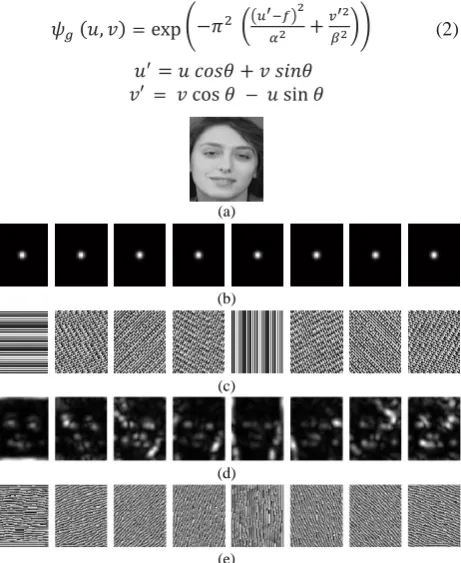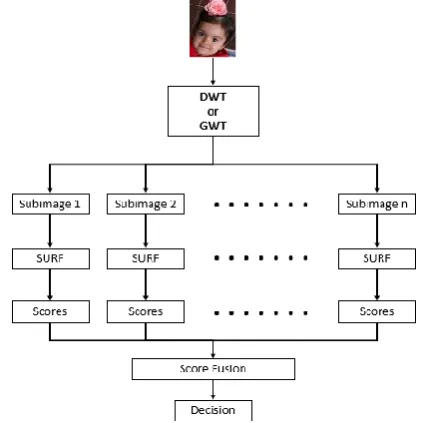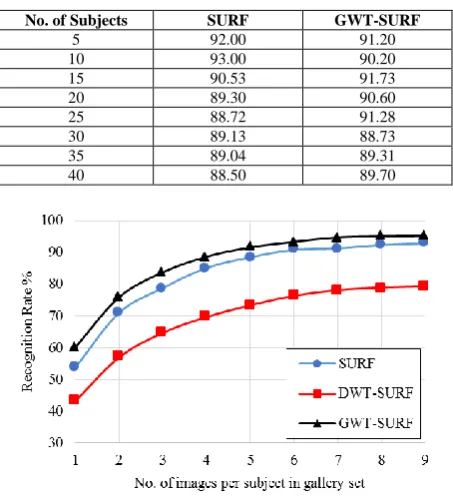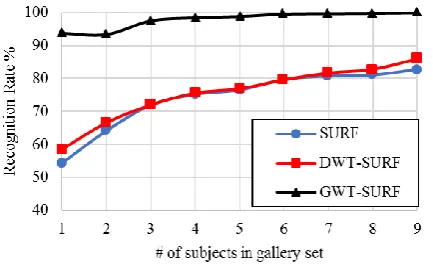Wavelet Transform Based Face Recognition
Using SURF Descriptors
Musa M. Ameen
Computer Engineering Department, Mevlana University, Konya, Turkey Email: musa.m.ameen@gmail.com
Alaa Eleyan and Gülden Eleyan
Mechatronics Engineering Department, Mevlana University, Konya, Turkey Email: {aeleyan, geleyan}@mevlana.edu.tr
Abstract—This paper presents a new approach to classify salient points as belonging to objects in the face classes. Speeded-Up Robust Features (SURF) algorithm is used to generate feature descriptors. SURF is applied on the subband images generated using either DWT Discrete Wavelet Transform (DWT) or Gabor Wavelet Transform (GWT). The matching scores obtained from these subband images are fused and final decision is reached. Experiments results indicate that our proposed approach showed increase in the performance for both wavelet transforms when applied on the well-known ORL and PUT face databases.
Index Terms—face recognition, speeded-up robust features, scale-invariant feature transform, discrete wavelet transform, Gabor wavelet transform
I. INTRODUCTION
Automatic face recognition is a major research area in computer vision which aims to recognize human face without human intervention. Significant developments in this field have shown that in many face recognition applications the automated algorithms outperform human [1]. The initiative was reported year back in 1960 where facial recognition was accomplished using geometric information [2]. Later Principle Component Analysis (PCA) [3] and Linear Discriminant Analysis (LDA) [4] based algorithms were developed. In recent days the efforts are continued with applications of different algorithms e.g. Radon and wavelet transforms [5], tensor subspace analysis and view manifold modeling [6], Local Fisher Discriminant analysis [7], incremental complete LDA [8], etc. Despite of huge researches in system performance due to different stimuli e.g. face recognition, illumination, orientation, age, etc. it remains as one of the major challenges. At the same time the algorithms need to be inexpensive in terms of memory and time.
This paper presents a face recognition approach that involves dynamics of SURF algorithm [9] which is a robust detector of local features in an image. It is a development over Shift Invariant Feature Transform (SIFT) [10] and computes integer approximation to the
Manuscript received February 23, 2016; revised June 3, 2016.
determinant of Hessian blob detector with integral images [9]. It has been employed in many feature detection tasks including face recognition [11], [12]. In the presented work the SURF algorithm is adopted for automatic detection and description of the key-points in the subband images obtained after applying wavelet transforms such as DWT or GWT to capture the orientation information in the images.
Inclusion of wavelet transform is towards developing an orientation invariant method. The inclusion of wavelet transform is also aimed to achieve improvement over performance of conventional SURF [9] algorithm.
Yang et al wrote a survey of research on face detection up to early 2001 [13]. They classify face detection methods into four categories such as knowledge-based, template matching, appearance-based methods, and feature invariant approaches.
Concerning feature extraction, there are many papers in the field of visually salient regions and obtaining descriptors for such regions according to the tutorial introduction [14] to salient point detectors. Since the first corner detectors, the Moravec corner detection algorithm, were developed in the late 1970’s, dozens of interest point detectors have been proposed such as a Hessian detector, Harris detector [15], Hessian/Harris-Laplacian/Affine detector [16] based on affine normalization around Harris and Hessian points, MSER (Maximally Stable Extremal Regions) [17] detector, (SIFT) Scale Invariant Feature Transform [10] detector, and Speeded-Up Robust Features (SURF) [9] detector. Here, we aim at recognize faces with the best accuracy. We assess SURF features for classification of faces. The keypoints in different face subband images are automatically detected by SURF algorithm after wavelet transformation of face images.
II. SPEEDED-UP ROBUST FEATURES
Among different feature extraction algorithms which can identify objects in an image irrespective of wide change of scale, affine transformation and illumination from one image to another is the SURF algorithm. Its distinctive features which can be extracted from any face image to perform effective and robust matching between images of same person with different expression and pose. These features are invariant to image scale i.e. size and rotation and can be used for wide range of affine transformations.
Feature vectors through SURF [9] are formed by means of local patterns around keypoints which are detected using scaled up filter. Following are the major steps to determine the SURF feature vectors of a given image:
1) Keypoint detector: At this step, SURF keypoints are detected using Hessian matrix approximation. The second order Gaussian derivatives for Hessian matrix are approximated using box filters. Keypoints are localized in scale and image space by applying nonmaximum suppression in a 3×3×3 neighborhood.
2) Key-point descriptor: This stage describes the keypoints. It fixes a reproducible dominant orientation based on information from a circular region around the interest point. Feature vector of 64 values is computed from the oriented square local image region around keypoint.
SURF can be an efficient alternative for automatic selection of interest points across face image which can be used for extracting features. Fig. 1 shows examples of keypoints detected with SURF descriptor.
Figure 1. Interest points in a face image using SURF.
III. WAVELET TRANSFORM
Gabor Wavelets Transform (GWT) is best known as tunable filters appropriate for capturing orientation information from the image [20]. Apart from orientation, it can also give the phase information of the pixel which is invariant to illumination. Further, it is also an effective tool for capturing the texture.
A Gabor wavelet filter is a Gaussian kernel function modulated by a sinusoidal plane wave
𝜓𝑔(x, y) =𝜂𝛾𝜋𝑓2 exp(𝛽2𝑦′2 – 𝑎2𝑥′2) exp(2𝜋 𝑗 𝑓 𝑥′) (1) 𝑥′= 𝑥 𝑐𝑜𝑠𝜃 + 𝑦 𝑠𝑖𝑛𝜃
𝑦′= 𝑦 cos 𝜃 − 𝑥 sin 𝜃
where f is the central frequency of the sinusoidal plane wave, θ is the anticlockwise rotation of the Gaussian and the envelope wave, α is the sharpness of the Gaussian along the major axis parallel to the wave, and β is the sharpness of the Gaussian minor axis perpendicular to the wave. γ = f /α and η = f /β are defined to keep the ratio between frequency and sharpness constant [21]. The 2D Gabor wavelet as defined in (1) has Fourier transform:
𝜓𝑔 (𝑢, 𝑣)=exp (−𝜋2 ( (𝑢′−𝑓)2
𝛼2 + 𝑣′2
𝛽2)) (2)
𝑢′= 𝑢 𝑐𝑜𝑠𝜃 + 𝑣 𝑠𝑖𝑛𝜃
𝑣′ = 𝑣 cos 𝜃 − 𝑢 sin 𝜃
(a)
(b)
(c)
(d)
(e)
Figure 2. (a) The original image, (b) the magnitude (c) phase of the Gabor kernels at 1 scale and 8 angles, (d) the magnitude and (e) phase
results of convolved face image with Gabor kernels.
The representation is also insensitive to illumination variations due to the fact that it lacks the DC component. Last but not least, there is a strong biological relevance of processing images by Gabor wavelets as they have similar shapes to the respective fields of simple cells in the primary visual cortex [20].
The 2D Discrete Wavelet Transform (2D-DWT) of a signal is implemented by iterating the 2D analysis filter bank on the approximate subband images. Here, at each scale there are four subband images generated instead of one, namely; approximation (A), horizontal (H), vertical (V) and diagonal (D). Size of the subband images is one fourth of the size of the original image.
Multiple levels (scales) are made by repeating the filtering and decimation process on the approximate output as shown in Fig. 3. In Fig. 4, DWT applied on an image, outputs four different subband images.
Figure 3. 2D-DWT decomposition.
Figure 4. 2D-DWT decomposition of an image.
Each subband image provides different information about the image. The approximation subband image is a coarse approximation of the image and removes all high frequency information. The horizontal subband image removes high frequency information along the rows and emphasizes high frequency information along the columns so it results in an image with emphasized vertical edges. The vertical subband image emphasizes horizontal edges, while the diagonal subband image emphasizes diagonal edges.
IV. THE PROPOSED APPROACH
The proposed algorithm uses transformation of face images using DWT or GWT. SURF is used to extract features from generated subband images. Fig. 5 describes block diagram of our proposed approach. The proposed approach can be outlined as following steps:
Step 1: Get the face image.
Step 2: Transform face image by using DWT or GWT. DWT creates 4 subband images. (1 scale, 4 angles) GWT creates 8 subband images. (1 scale, 8 angles) Step 3: Detect SURF keypoints from subband images. Step 4: Extract features from SURF keypoints.
Step 5: Sum matching scores from the subband images. Step 6: Make Decision based on highest summed scores.
Figure 5. The block diagram of proposed approach.
V. EXPERIMENTAL RESULTS
Experiments are performed to evaluate the performance of the proposed algorithm, and the results are compared with that of using SURF. The data sets we used in the experiments are PUT and ORL standard datasets were images have different head pose variations and are taken at different times. There are 200 images in probe set and 200 images in gallery set, 10 images for one subject. Different number of images per subject was also used to test our proposed approach. In our experiments, features of SURF, DWT-SURF and GWT-SURF are used.
10-fold was used to test performance. The program ran 10 times, each time with different randomly chosen images for each subject. The results recorded in following figures and tables are averaged results.
A. Results for ORL Face Images
Firstly 1 scale of DWT transformation was applied on face images, using different wavelet filters, results are listed in Table I.
TABLE I. RECOGNITION RATE OF 1-SCALE DWT-SURFUSING
DIFFERENT WAVELET FILTERS
Wavelet Filters Recognition Rate (%)
db1 76.82
db2 76.72
db3 77.51
db4 75.32
db5 78.55
Performance of proposed approach was not good enough. This can be due to the problem we faced after transformation. SURF did not extract enough features to describe face images. For approximate subband image, there was zero SURF points for all images in test and train sets. So we had to use only horizontal, vertical and diagonal subband images of 2D-DWT decomposition. Results of applying SURF algorithm on subband images of DWT can be observed from Fig. 6.
Figure 6. Performance of 1-scale DWT-SURF using ORL database.
The performance of our proposed approach was completely different when Gabor Wavelets Transform (GWT) was applied on face images before detecting and describing features from face image. 1 scale and 8 angles are used in the experiment setup. SURF algorithm was applied on the magnitude of the 8 subband images of GWT. Performance of proposed approach is compared with SURF algorithm and shown in Table II.
With different number of images per subject in gallery set, respond of our proposed approach was tested against SURF. As shown in Fig. 7 there is an improvement in GWT-SURF over SURF only. But for DWT-SURF, the results were not good enough.
TABLE II. RECOGNITION RATES OF SURF AGAINST GWT-SURF FOR
ORLDATABASE
No. of Subjects SURF GWT-SURF
5 92.00 91.20
10 93.00 90.20
15 90.53 91.73
20 89.30 90.60
25 88.72 91.28
30 89.13 88.73
35 89.04 89.31
40 88.50 89.70
Figure 7. The performance of SURF, DWT-SURF and GWT-SURF using different number of images per subject for ORL database.
B. Results for PUT Face Images
Same experiments as of applied on ORL face database were also applied on PUT face images so firstly 1 scale of DWT transformation was applied on face images, using different wavelet filters, results are listed in Table III.
Performance of proposed approach was better with PUT face images compared to ORL face images. Since the size of PUT face images were higher than ORL face images so SURF was able to extract enough features to describe face images. For approximate subband image, there was enough keypoints while in ORL it was zero SURF points for all images in test and train sets.
TABLE III. RECOGNITION RATE OF 1-SCALE DWT-SURFUSING
DIFFERENT WAVELET FILTERS FOR PUTDATABASE
Wavelet Filters Recognition Rate (%)
db1 87.05
db2 84.77
db3 83.16
db4 83.36
db5 86.99
haar 87.05
Based on this, we used approximate, horizontal, vertical and diagonal subband images of 2D-DWT decomposition. For DWT algorithm we can conclude that there is approximately ~1% difference between 1 scale and 2-scales transformations. One can observe the average performance differences from Fig. 8 which is quite close to each other.
Figure 8. Performance of 2-scale DWT-SURF using PUT database.
TABLE IV. RECOGNITION RATES OF SURF AGAINST GWT-SURF FOR
PUTDATABASE
No. of Subjects SURF GWT + SURF
5 90.40 99.60
10 88.40 98.80
20 88.80 99.30
30 89.13 99.53
40 86.05 98.90
50 84.98 99.02
60 81.38 99.16
70 79.66 99.23
80 79.76 99.20
90 78.75 99.15
100 76.57 98.82
Performance of proposed approach is compared with SURF algorithm and shown in Table IV.
Figure 9. The performance of SURF, DWT-SURF and GWT-SURF using different number of images per subject for PUT database.
With different number of images per subject in gallery set, respond of our proposed approach was tested against SURF. As shown in Fig. 9 there is an improvement in DWT-SURF and GWT-SURF over SURF only.
VI. CONCLUSION
In this paper wavelet transform based feature extraction method is proposed for face recognition. The ORL and PUT database images were used to test the proposed approach. DWT and GWT was applied on facial images to normalize expression and illumination variations. Feature descriptors are obtained by using SURF over the subband images. It is observed that while the performance dropped with DWT, it showed improvement in the case of the proposed approach with GWT compared to the existing SURF. In future work, the proposed approach may be tested by fusing features of individual transformations and different scales. Also, SURF can be tested on Dual-Tree Complex Wavelet Transform (DT-CWT) subband images as well.
REFERENCES
[1] A. J. O'Toole, P. J. Phillips, F. Jiang, J. Ayyad, N. Pénard, and H. Abdi, “Face recognition algorithms surpass humans matching faces over changes in illumination,” IEEE Trans. Pattern Analysis and Machine Intelligence, vol. 29, pp. 1642-1646, 2007.
[2] W. W. Bledsoe, “Man-Machine facial recognition,” Technical Report PRI 22, Panoramic Research, Inc., Palo Alto, California, 1966.
[3] M. A. Turk and A. P. Pentland, “Eigenfaces for recognition,” J. of Cognitive Neuroscience, vol. 3, pp. 71-86, 1991.
[4] P. N. Belhumeur, J. P. Hespanha, and D. J. Kriegman, “Eigenfaces ” IEEE Trans. Pattern Analysis and Machine Intelligence, vol. 19, pp. 711-720, 1997.
[5] A. Eleyan and H. Demirel, “Face recognition system based on PCA and feedforward neural networks,” Computational Intelligence and Bioinspired Systems, vol. 3512, pp. 935-942, 2005.
[6] X. Gao and C. Tian, “Multi-View face recognition based on tensor subspace analysis and view manifold modeling,” Neurocomputing, vol. 72, pp. 3742-3750, 2009.
[7] H. Huang, H. Feng, and C. Peng, “Complete local fisher discriminant analysis with laplacian score ranking for face recognition,” Neurocomputing, vol. 89, pp. 64-77, 2012.
[8] G. F. Lu, J. Zou, and Y. Wang, “Incremental complete LDA for face recognition,” Pattern Recognition, vol. 45, pp. 2510-2521, 2012.
[9] H. Bay, T. Tuytelaars, and L. Gool, “SURF: Speeded up robust features,” in Proc. 9th European Conference on Computer Vision, 2006, pp. 404-417.
[10] D. G. Lowe, “Distinctive image features from scale invariant keypoints,” International Journal of Computer Vision, vol. 60, pp. 91-110, 2004.
[11] G. Hermosilla, J. Ruiz-Del-Solar, R. Verschae, and M. A. Correa, “Comparative study of thermal face recognition methods in unconstrained environments,” Pattern Recognition, vol. 45, pp. 2445-2459, 2012.
[12] M. Kang, W. Choo, and S. Moon, “Improved face recognition algorithm employing SURF descriptors,” in Proc. SICE Annual Conference, 2010, pp. 2511-2513.
[13] M. H. Yang, D. Kriegman, and N. Ahuja, “Detecting faces in images: A survey,” IEEE Transactions on Pattern Analysis and Machine Intelligence, vol. 24, no. 1, pp. 34-58, 2002.
[14] T. Tuyttellaars, “Local Invariant Features: What? Why? When? How?” in Proc. European Conference on Computer Vision, 2006. [15] K. Mikolajczyk and C. Schmid, “An affine invariant interest point
detector,” in Proc. European Conference on Computer Vision, Copenhagen, Denmark, 2002, pp. 128-142.
[16] C. Harris and M. Stephens, “A combined corner and edge detector,” in Proc. Fourth Alvey Vision Conference, Manchester, UK, 1988, pp. 147-151.
[17] J. Matas, O. Chum, M. Urban, and T. Pajdla, “Robust wide baseline stereo from maximally stable extremal regions,” Image and Vision Computing, vol. 22, no. 10, pp. 761-767, 2004. [18] F. Samaria and A. Harter, “Parameterization of a stochastic model
for human face identification,” in Proc. 2nd IEEE Workshop on Applications of Computer Vision, Sarasota FL, 1994.
[19] A. Kasiński, A. Florek, and A. Schmidt, “The PUT face database,” Image Processing & Communications, vol. 13, no. 3-4, pp. 59-64, 2008.
[20] A. Eleyan, H. Özkaramanli, and H. Demirel, “Complex wavelet transform-based face recognition,” EURASIP Journal on Advances in Signal Processing, 2008.
[21] L. Shen, L. Bai, and M. Fairhurst, “Gabor wavelets and general discriminant analysis for face identification and verification,” Image and Vision Computing, vol. 25, no. 5, pp. 553-563, 2007.
Musa M. Ameen received the B.Sc. degree in
computer engineering from Ishik University in Erbil, Iraq, in 2013, and M.Sc. degree in computer engineering from Mevlana University, Konya, Turkey in 2016. His current research interests are biometrics and signal processing.
Gülden Eleyan received her B.Sc. degree in
electrical & electronics engineering from Near East University, Northern Cyprus in 2003 and M.Sc. degree in electronics engineering from Ankara University, Turkey in 2010. In 2016, she finished her PhD degree in electrical and computer engineering from Mevlana University, Konya, Turkey. Currently, she is working as an assistant professor at Mevlana University, Turkey. Her research interests are adaptive filtering and image processing.
Alaa Eleyan received the B.Sc. and M.Sc.
degrees in electrical & electronics engineering from Near East University, Northern Cyprus, in 2002 and 2004, respectively. In 2009, He finished his PhD degree in electrical and electronics engineering from Eastern Mediterranean University, Northern Cyprus. Currently, he works as an assistant professor at Mevlana University, Turkey. His current research interests are biometrics, computer vision and image processing. He has more than 50 published journal and conference papers in the computer vision and image processing research fields.



